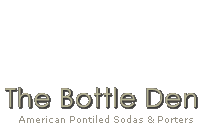Featured Article: Mold Variations
Many years ago, I came across a small cache of late 1880's beers scattered about some bondfire ash, just below the top soil. There were six Baltimore Branch PABST beers among these, which all looked exactly the same.
I took these bottles to Bill Schramm, a venerable Baltimore beer collector, to see if we could make a trade. "Which one do you want?" I asked Bill.
"All of them," he replied, "they're all different".
Sure enough, as Bill pointed out the minute differences in the shape of the hop leaf emblems, and the the size and placement of letters, I could see that, of the six bottles I initially thought were exactly the same, no two were in fact identical. I have looked at mold work detail with a much keener eye ever since, including even the early molds used in pontil-era production.
Take for example the mold variations of the Hopkin's Chalybeate and Carter's Spanish Mixture, both products of the Federal Hill Glassworks.
Looking closely at the Hopkins, there are two distinct mold variants which I have termed the "Wide K" and "Normal K" molds, respectively. In the "Wide K mold", we see two noticeable distinctions.
First is the self-explanatory wide "K" in "HOPKINS".
Second is the "tight LT" in "BALTIMORE", in which the two letters are noticeably more "squeezed" together in the "Wide K" mold.
I believe the "Wide K" to be earlier, finished normally with an iron pontil (one open pontil example reported) however both variants continue into the smooth base era.
Looking at the Carter's, we notice "similar differences". Most noticeable is the addition of the apostrophe between the "R" and the "S" in "CARTER'S" of the later mold, which is nearly always iron pontiled, has generally larger, wider letters and usually has a shorter neck than the earlier mold. Labeled examples of the "apostrophe" mold locate the Proprietors, Bennet & Beers, at "No. 3 Pearl Street", whereas the earlier "Long Neck" mold identifies their location as "125 Main St.". This earlier mold occurs with both iron and open pontiled bases.
While bottlers would intentionally vary embossing and form to identify different product, a new address or partnership, some of these variations appear to be as close to the original as hand-crafted mold work can achieve.
Were these "near exact" variants the result of broken, worn-out or lost mold replacements? Were they produced by a competitive glasshouse or mold-maker? We may never know, but in some cases, certain variants may have had a much shorter production run than others, making these examples much more scarce.
